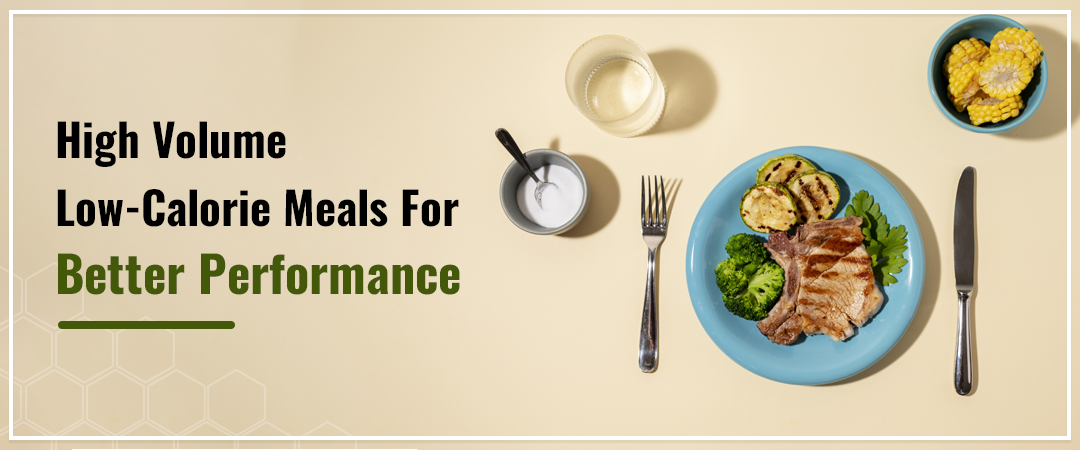
Benefits Of High Volume Low-Calorie Meals For Better Performance?
Introduction
Eating for performance is not just about the quantity of food, but also the quality. High volume low-calorie meals can offer a host of benefits for athletes, fitness enthusiasts, and anyone looking to improve their overall health and performance.
With lower calorie intake, you can maintain a healthy weight, control hunger, and provide your body with the nutrients it needs to thrive. In this post, we will explore the advantages of consuming high volume low-calorie meals and how it can help you achieve your fitness goals.
Benefits of Eating High Volume Low-Calorie Meals
Here are 5 benefits of eating high volume low-calorie meals.
1. Weight Management
Weight management is a critical aspect of overall health and fitness. High volume low-calorie meals can help individuals achieve and maintain a healthy weight. Consuming meals that are high in volume but low in calories can provide a sense of fullness, making it easier to stick to a calorie-controlled diet.
This type of eating pattern has been shown to lead to a reduction in body fat and improved weight management compared to a low-volume high-calorie diet. By focusing on nutrient-dense, high-volume foods such as fruits, vegetables, and lean proteins, individuals can reduce their calorie intake while still feeling satisfied and full.
2. Improved Nutrient Density
Improved nutrient density is another advantage of consuming high volume low-calorie meals. When you eat more volume of food with fewer calories, you’re able to consume a larger variety of nutrient-dense foods.
This leads to a more balanced and diversified nutrient intake, providing your body with the vitamins, minerals, and other nutrients it needs to function optimally. High volume low-calorie foods, such as fruits, vegetables, whole grains, and lean proteins, are typically nutrient-dense and can help individuals meet their daily recommended nutrient intake while still controlling their calorie intake.
This can be especially beneficial for athletes or individuals with physically demanding lifestyles who require additional nutrients to fuel their bodies and support recovery.
3. Increased Satiety
One of the key benefits of high volume low-calorie meals is increased satiety, or the feeling of fullness after eating. Foods that are high in volume and low in calories, such as fruits and vegetables, tend to be more satisfying because they take up more space in your stomach and slow down the digestive process.
This leads to a sustained feeling of fullness, reducing the urge to snack or overeat. High volume low-calorie meals can also help control hunger hormones, such as ghrelin, which can regulate feelings of hunger and fullness.
By controlling hunger, individuals are better able to stick to their diet and reach their weight management and fitness goals.
4. Better Athletic Performance
Eating high volume low-calorie meals can also improve athletic performance. A well-balanced diet that includes a variety of nutrient-dense foods can provide the energy and nutrients necessary for peak performance.
Consuming high volume low-calorie meals can also help maintain a healthy weight, which is essential for optimizing athletic performance. In addition, these types of meals can help regulate blood sugar levels, providing sustained energy throughout the day and during physical activity.
This is particularly important for athletes who engage in long-duration or high-intensity exercise, as they need a steady source of fuel to maintain their performance. By incorporating high volume low-calorie meals into their diet, athletes can support their performance and achieve their fitness goals.
5. Improved digestion and gut health
Improved digestion and gut health are additional benefits of incorporating high volume low-calorie meals into your diet. Foods that are high in fiber, such as fruits, vegetables, whole grains, and legumes, promote regularity and help keep the digestive system functioning smoothly. Fiber also supports the growth of beneficial bacteria in the gut, which can help improve gut health and boost overall wellness.
In addition, consuming high volume low-calorie meals can reduce the risk of digestive issues such as bloating, constipation, and acid reflux. These meals are generally easier for the body to digest, as they are lower in fat and processed ingredients. This can lead to improved digestion and a reduced risk of digestive discomfort. Check out these upper chest workouts with dumbbells.
Overall, incorporating high volume low-calorie meals into your diet can support better digestion and gut health, contributing to improved overall wellness and a healthier lifestyle.
How to Incorporate High Volume Low-Calorie Meals into Your Diet?
Here are a few tips for incorporating high volume low-calorie meals into your diet:
Focus on fiber-rich foods: Foods that are high in fiber, such as fruits, vegetables, whole grains, and legumes, are generally low in calories and provide a high volume of food. This can help you feel full while also providing essential nutrients and fiber.
Use low-calorie cooking techniques: When preparing meals, focus on low-calorie cooking techniques such as baking, grilling, or steaming. Avoid high-calorie cooking methods, such as deep-frying, that can add unnecessary calories to your meals.
Plan your meals: Planning your meals in advance can help you ensure that you’re incorporating high volume low-calorie meals into your diet. This can involve prepping and cooking meals in advance, or planning your meals around high-volume low-calorie foods.
By following these tips and incorporating high volume low-calorie meals into your diet, you can support your weight management, nutrition, and athletic performance goals.
Examples of High Volume Low-Calorie Meals
Here are a few examples of high volume low-calorie meals:
- Veggie stir-fry with broccoli, carrots, bell peppers, and tofu.
- Whole grain pasta with marinara sauce, grilled vegetables, and lean protein such as turkey or shrimp.
- Baked sweet potato topped with black beans, salsa, and plain Greek yogurt.
- Grilled fish with roasted vegetables and a side salad.
These meals provide a high volume of food, are low in calories, and are packed with essential nutrients and fiber. By incorporating these types of meals into your diet, you can feel full and satisfied while still managing your calorie intake.
Conclusion
In conclusion, incorporating high volume low-calorie meals into your diet has numerous benefits, including weight management, improved nutrient density, increased satiety, and better athletic performance. These meals can help you feel full and satisfied while still controlling your calorie intake, and they provide a balanced and diverse source of essential nutrients.
By focusing on high-volume, low-calorie foods such as fruits, vegetables, whole grains, and lean proteins, you can support your health and fitness goals and improve your overall quality of life. Whether you’re trying to lose weight, improve your nutrition, or optimize your athletic performance, incorporating high volume low-calorie meals into your diet is a simple and effective way to support your goals.


You May Also Like

Best Ways to Stay Fit and Healthy Regardless of Your Routine
March 17, 2023
Why Should I Take Care of My Diet as a Mother?
November 16, 2022
